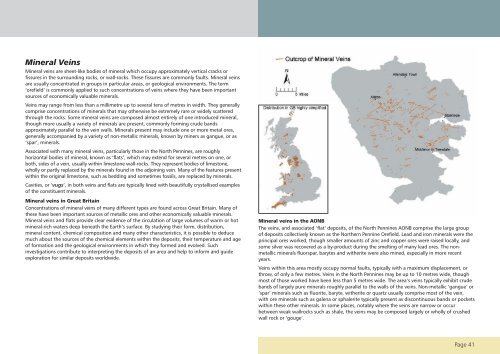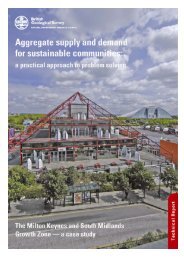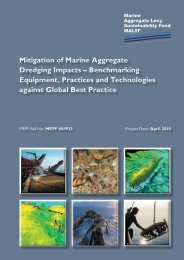North Pennines - Sustainable Aggregates
North Pennines - Sustainable Aggregates
North Pennines - Sustainable Aggregates
You also want an ePaper? Increase the reach of your titles
YUMPU automatically turns print PDFs into web optimized ePapers that Google loves.
Mineral Veins<br />
Mineral veins are sheet-like bodies of mineral which occupy approximately vertical cracks or<br />
fissures in the surrounding rocks, or wall-rocks. These fissures are commonly faults. Mineral veins<br />
are usually concentrated in groups in particular areas, or geological environments. The term<br />
‘orefield’ is commonly applied to such concentrations of veins where they have been important<br />
sources of economically valuable minerals.<br />
Veins may range from less than a millimetre up to several tens of metres in width. They generally<br />
comprise concentrations of minerals that may otherwise be extremely rare or widely scattered<br />
through the rocks. Some mineral veins are composed almost entirely of one introduced mineral,<br />
though more usually a variety of minerals are present, commonly forming crude bands<br />
approximately parallel to the vein walls. Minerals present may include one or more metal ores,<br />
generally accompanied by a variety of non-metallic minerals, known by miners as gangue, or as<br />
‘spar’, minerals.<br />
Associated with many mineral veins, particularly those in the <strong>North</strong> <strong>Pennines</strong>, are roughly<br />
horizontal bodies of mineral, known as ‘flats’, which may extend for several metres on one, or<br />
both, sides of a vein, usually within limestone wall-rocks. They represent bodies of limestone,<br />
wholly or partly replaced by the minerals found in the adjoining vein. Many of the features present<br />
within the original limestone, such as bedding and sometimes fossils, are replaced by minerals.<br />
Cavities, or ‘vugs’, in both veins and flats are typically lined with beautifully crystallised examples<br />
of the constituent minerals.<br />
Mineral veins in Great Britain<br />
Concentrations of mineral veins of many different types are found across Great Britain. Many of<br />
these have been important sources of metallic ores and other economically valuable minerals.<br />
Mineral veins and flats provide clear evidence of the circulation of large volumes of warm or hot<br />
mineral-rich waters deep beneath the Earth’s surface. By studying their form, distribution,<br />
mineral content, chemical composition and many other characteristics, it is possible to deduce<br />
much about the sources of the chemical elements within the deposits, their temperature and age<br />
of formation and the geological environments in which they formed and evolved. Such<br />
investigations contribute to interpreting the deposits of an area and help to inform and guide<br />
exploration for similar deposits worldwide.<br />
Mineral veins in the AONB<br />
The veins, and associated ‘flat’ deposits, of the <strong>North</strong> <strong>Pennines</strong> AONB comprise the large group<br />
of deposits collectively known as the <strong>North</strong>ern Pennine Orefield. Lead and iron minerals were the<br />
principal ores worked, though smaller amounts of zinc and copper ores were raised locally, and<br />
some silver was recovered as a by-product during the smelting of many lead ores. The nonmetallic<br />
minerals fluorspar, barytes and witherite were also mined, especially in more recent<br />
years.<br />
Veins within this area mostly occupy normal faults, typically with a maximum displacement, or<br />
throw, of only a few metres. Veins in the <strong>North</strong> <strong>Pennines</strong> may be up to 10 metres wide, though<br />
most of those worked have been less than 5 metres wide. The area’s veins typically exhibit crude<br />
bands of largely pure minerals roughly parallel to the walls of the veins. Non-metallic ‘gangue’ or<br />
‘spar’ minerals such as fluorite, baryte, witherite or quartz usually comprise most of the vein,<br />
with ore minerals such as galena or sphalerite typically present as discontinuous bands or pockets<br />
within these other minerals. In some places, notably where the veins are narrow or occur<br />
between weak wallrocks such as shale, the veins may be composed largely or wholly of crushed<br />
wall rock or ‘gouge’.<br />
Page 41

















